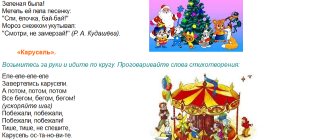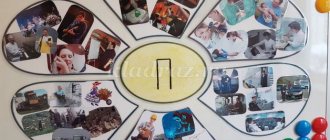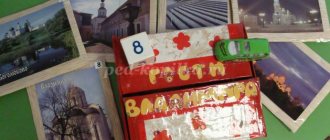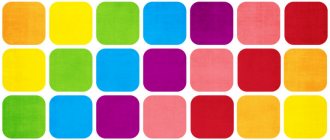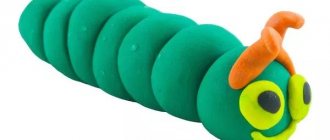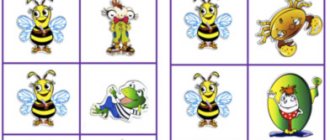Didactic games on mathematical development for children
Didactic games (DI), as a special educational tool that meets the characteristics of the child, are included in all preschool education systems of the Federal State Educational Standard. The importance of DI for the mental education of preschool children is important. In games, children of different groups (younger, middle, older) accumulate sensory experience.
Preschool game
By disassembling, folding, picking up, they learn to see and name the signs of objects:
- size;
- shape;
- color.
For your information. Exciting creative activities create interest in kindergarten students in solving mental problems; mental effort and overcoming difficulties bring pleasure.
Children fold
Why is this necessary, tasks of teaching mathematics
Every kindergarten student is a child explorer, discovering the amazing planets with joy and pleasure.
The teacher's task:
- help;
- preserve and develop the desire to learn new things;
- satisfy the need for mental development.
More complete development of a preschooler is influenced by high-quality education and learning, carried out taking into account the characteristics of the children’s age.
For your information. While playing, the pupil acquires the skills to distinguish the signs of objects, experience various movements and actions. And all this leads to basic knowledge and skills, implemented in the form of interesting, easy-to-understand didactic games.
Structure and time frame of the FEMP lesson
Didactic games are performed once every 7 days and last half an hour. It is important that the activities evoke positive emotions in children and are understandable. For this purpose, teachers resort to creating DI. The structure provides interesting storylines:
- journey;
- competition;
- treasure hunt;
- rescuing a hero in trouble.
Various experiments and experiments are often used. In order to support cognitive activity, the teacher uses ingenuity riddles, creative tasks, and specifically complicates situations that the students must resolve themselves.
Didactic games and exercises in mathematics for children 4 - 6 years old
Didactic games and exercises in mathematics for preschoolers
This brochure presents games that can be used at home to help a child develop mathematical abilities using gaming methods and techniques.
And also as a didactic manual for individual developmental and correctional classes, and for classes on the formation of elementary mathematical concepts in kindergarten. The concept of “formation of mathematical abilities” is quite complex and complex. It consists of interrelated and interdependent ideas about space, shape, size, time, quantity, which are necessary for the cognitive development of the child. We want to show you how you can help your child develop mathematical abilities at home using gaming methods and techniques. Children's games are excellent helpers in a child's development. The game is beneficial because it unobtrusively teaches new skills, develops children's thinking and imagination, and helps to establish control over behavior. In a playful form, it is easier and more effective to convey information, teach how to concentrate attention and solve problems. The process brings joy and pleasure to the child, he easily turns on and shows genuine interest, independently understands tasks and actively searches for answers, tries to cope with difficulties. Didactic games and play exercises also act as a means of comprehensive education of the child’s personality. What does comprehensive development of a child mean? If adults devote 10-15 minutes to their child, the child will speak correctly and think logically and will be your smartest and most developed child. The role of didactic games and game exercises in the formation of elementary mathematical concepts in preschoolers is very great. They help the child learn how the world around him works and broaden his horizons. The home environment contributes to the child’s liberation and he learns educational material at his own pace, consolidating the knowledge acquired in kindergarten. Parents, in turn, learn a lot about their child. Therefore, we can recommend some mathematical games and exercises for doing them with the family. These games are available for children starting from early preschool age, and do not require lengthy preparation or production of complex didactic material
“Match the wheels to the trailers”
Purpose of the game:
learning to distinguish and name geometric shapes, establishing correspondence between groups of shapes, counting to 5.
Progress of the game: the child is asked to select the appropriate wheels - red wheels for the blue trailer, and blue wheels for the red one.
Then you need to count the wheels from left to right for each carriage separately (cars and wheels can be cut out of colored cardboard in 5-10 minutes). "Days of the week"
Game exercise - What day of the week is the 1st (3rd, 5th) in a row?: -Today is Friday. What day will it be tomorrow? -Thursday – what day is it? — What day of the week will be after Tuesday? -What day is between Thursday and Tuesday? -How many days are there in a week?
“Name a similar item”
Game exercise
Purpose of the game:
development of visual attention, observation and coherent speech.
Progress of the game
: an adult asks the child to name objects that are similar to different geometric shapes, for example, “Find what looks like a square” or find all the round objects... This game can easily be played while traveling or on the way home.
“Find and name”
Goal
: consolidate the ability to quickly find a geometric figure of a certain size and color.
Procedure: 10-12 geometric shapes of different colors and sizes are laid out in chaos on the table in front of the child.
The presenter asks to show various geometric shapes, for example: a large circle, a small blue square, etc. Orientation in space
Game exercise Place any toys around the child on four sides (left, right, front, back). Questions: Who is standing to your right (left)? Who is standing in front (behind) of you? Where is the hare? (to my left) Where is the car? (behind me), etc.
"Collect the beads"
Game exercise
Purpose of the game:
to develop the perception of color, size;
ability to generalize and concentrate attention; speech. Progress of the game : for sequences, you can use a Lego constructor, figures cut out of paper (but I prefer figures made from kitchen cellulose napkins - they are more convenient to work with), and any other objects.
“Who knows, let him keep counting”
Game exercise For example, an adult calls the number 5 and says: “Count further” (and so on with any number up to 10). Name the numbers before 6 (5, 3, 4, etc.) Name the numbers after 3 (4, 7, 6, etc.) Name the number that is 1 more (or 1 less than the one named). Counting in a chain (one at a time). The adult starts - “one”, the child continues - “two”, the adult - “three”, the child - “four”, etc. up to 10. Then the child starts counting first.
“Orientation in space”
Game exercise Who is where? Place any toys around the child on four sides (left, right, front, back). Questions: Who is standing to your right (left)? Who is standing in front (behind) of you? Where is the hare? (to my left) Where is the car? (behind me), etc.
We recommend watching:
Didactic game for preschoolers for the development of fine motor skills Passport of the mathematics corner of the senior group Mathematical fairy tales for children 5-7 years old Summary of a lesson on FEMP in the preparatory group of a preschool educational institution. Forest adventures
Similar articles:
Math games for children 5 years old
Math games for a 6 year old child
Math tasks in pictures for children 6-7 years old
Exercises with counting sticks for preschoolers
Teaching mathematics using the Nikitin method
The role of didactic games in FEMP classes in kindergarten
The age of 5-6 years is the most important time in a child’s life. At this time, fantasy and logic are formed, the arbitrariness of mental processes and self-esteem are formed. Children always want to know - why, how, why?
Lesson with numbers
At the preschool educational institution, the preparatory process for an educational institution begins, and cognitive activity develops. This is precisely the goal pursued by FEMP pedagogy. Children must not only be able to count to 10 back and forth, but also analyze information data, conduct analysis, classify different phenomena, find common patterns, be smart, and be able to explain and prove a personal point of view.
Independent learning of English with children from scratch
Types of Math Activities for Kindergarteners
Didactic mathematical games are divided into certain groups according to their content. Type of DI:
- with figures and numbers;
- time travel;
- orientation in space;
- with geometric shapes;
- to logic.
Thanks to different types of games, students are taught to count forward and backward, and to use actions according to the rules of numerals, both quantitative and ordinal.
Didactic games in mathematics
Training sessions involve the use of various pedagogical techniques:
- visibility;
- gaming technologies;
- verbal conversations;
- outdoor activities;
- frontal surveys.
A special place in the educational process belongs to the development of the student.
Game with geometric shapes
Any summary of FEMP in the middle group of the second year of study involves the use of visual materials:
- benefits;
- standards;
- pictures;
- photo.
For your information. This allows students to fully perceive objects, their qualities and characteristics.
Examples of homemade didactic games for FEMP
Mathematics and algebra by definition are plus and minus, triangular and square shapes, different quantities, greater than and less than signs. There is no need to invent a bicycle. Mathematical thinking is formed from the first year of life. A child from his crib observes a rectangular window, a round light bulb, a square sheet or a triangular scarf.
For your information. Everything that surrounds has the form of geometry. Therefore, independent activities with colored geometric figures will captivate the kindergartener 100%.
You can make the figures yourself from wood or cardboard. It is important that there are many of them and they are of different colors. Having the material, you can play and develop the child, select by colors, shapes, quantities, and so on.
Card index of games according to the Federal State Educational Standard
The card index is represented by different games. For example, it is worth considering the DI “Animal Conversation”. Its goal is to expand the child’s vocabulary and develop articulation.
In order to start playing, you need to take a ball. The students stand in a line, and the teacher opposite them explains the rules of the game and makes a presentation: he will name the animals and throw the ball to the first participant. The kid must catch the ball, say what sounds this animal makes, and return the ball to the teacher. Then the ball is thrown to the next participant. The game ends when the last ball in the line is received and the task is completed.
Coloring pages on traffic rules for a preschooler 3-4 years old
For your information. You can play differently: the teacher pronounces sounds, and the children must guess the animal that pronounces them.
Didactic games in mathematics (part 2)
Svetlana Varavka
Didactic games in mathematics (part 2)
Didactic games are one of the means of educating and teaching preschool children.
The idea of including games in the teaching and learning process has long attracted the attention of educators. K. D. Ushinsky emphasized the ease with which children acquire knowledge if accompanied by play. With the help of didactic games, preschoolers use their knowledge in new situations. Didactic games used in a modern preschool will help the teacher correctly and effectively organize work with preschoolers and teach the child to apply existing knowledge in practice.
A didactic game is a multifaceted, complex pedagogical phenomenon: it is a game method of teaching preschoolers, a form of education, an independent play activity, and a means of comprehensive education of a child’s personality.
Didactic game “Weight jars”
Goals and objectives of the game : development of fine motor skills of the hands, formation in children of ideas about the mass of an object and how to measure it. You can measure mass by weighing, as well as by applying a “baric feeling”
, provide children with the opportunity to feel the degree of gravity of objects, thereby enriching children’s sensory experience and developing the ability to talk about their sensory impressions.
Didactic game "Worms"
Goals and objectives of the game : development of fine and gross motor skills, coordination of movements, dexterity, to develop the ability to build basic conclusions, to justify one’s assumptions. Instill hard work.
Didactic game " Mathematical circle "
Goals and objectives of the game : practice counting objects by touch, learn the concept of “how much”
, formation of ideas about number and quantity, development of fine and gross motor skills, coordination of movements.
Didactic game “Count - don’t be mistaken”
Goals and objectives of the game : consolidate the ability to count objects and establish the correspondence of their quantity to a certain number, exercise the ability to distinguish numbers, practice counting.
Didactic game
«Math basket»
Goals and objectives of the game : to understand the concept of “how much”
, continue to introduce the quantitative composition of numbers within 10 using specific
material , help prepare children for the elementary mathematical operations of addition and subtraction.
Didactic game “Game to consolidate counting skills”
Goals and objectives of the game : teach to see an equal number of different objects, consolidate the ability to count objects, consolidate knowledge about geometric shapes. Development of fine and gross motor skills, coordination of movements, dexterity, and cultivation of perseverance.
Didactic game “Learning to fold”
Purpose of the game : to consolidate counting from 1 to 10, to form children’s ideas about numbers, to prepare children for learning addition and subtraction, to focus on the composition of numbers, to promote the development of logical thinking, and to instill interest in counting.
Didactic game
«Math box»
Goals and objectives of the game : development of fine and gross motor skills, coordination of movements, dexterity, to help prepare children for basic mathematical operations of addition and subtraction.
Didactic game "Magic Circles"
Goals and objectives of the game : to develop the ability to analyze, isolate the forms of an object being composed into parts , look for ways to connect one part to another ; develop in children logical thinking, combinatorial abilities, practical and mental actions, assemble circles from parts by quantity (for example, assemble a circle from 5 parts , name the parts of this circle (1/2,1/6., compare parts of different circles (1/ 5 > 1/6)
etc.
Didactic game
«Math tree»
Purpose of the game : continue to introduce the quantitative composition of numbers within 10 on specific material , consolidate forward and backward counting within 10.
Progress of game actions: for younger children - pull out the ribbon and lay out on the crown of the tree as many leaves as fall out in the window; for older children - a game with addition (children are asked to throw 2 dice, put them in special holes and add the dropped numbers in a way accessible to the child; then find the corresponding number on the tape and lay leaves on the crown of the tree.
Didactic game
"Pick up a patch"
Goals and objectives of the game : to teach children to distinguish and correctly name geometric shapes, to select shapes according to a visually perceived pattern.
development of fine and gross motor skills, coordination of movements, dexterity.
Thank you for your attention!
Methodology for conducting classes on FEMP in kindergarten
As a training base for those preparing to go to first grade, special methods are used:
- subsequence;
- consistency;
- individuality;
- logic.
The knowledge that the teacher imparts to children becomes more and more complex from lesson to lesson, taking into account the level of development of the students. For repetition, special role-playing games are used. Mathematics becomes the pupils’ favorite subject; they study with pleasure, look for similarities and differences in subjects, and focus on subtleties in order to answer the teacher’s question.
Game with the teacher
Recommendations for organizing classes
It is important to organize the game positively and competently. Kindergarten age does not provide for the use of unsatisfactory grades or reprimands from the teacher. You cannot compare one child with another; only an analysis of the student’s personal growth is allowed.
The teacher must use in his work those methods and techniques that provoke interest. “Forced” classes are useless and create aversion to mathematics and algebra.
For your information. If there is personal contact and a positive relationship between the student and his mentor, there will be a successful outcome.
An example of a calendar-thematic lesson plan for FEMP
In the morning, the teacher talks about the heroes of the fairy tale “Turnip”. Together, participants look at pictures of characters. Next, during the walk, the participants play the game “Line up like a turnip in a fairy tale,” and at lunchtime the teacher tells the fairy tale “Turnip.” In the evening, the fairy tale is played out, and unconventional drawing of geometric shapes takes place. During the second walk, the children and the teacher play “Edible-Inedible” (with a ball) and put together the “Turnip” puzzle. They create costumes for the fairy tale “Turnip”.
The Federal State Educational Standard for kindergartens contains a list of concepts that should be developed by graduates of preschool educational institutions.
